turn signal bulb CHEVROLET TRAVERSE 2009 1.G Owners Manual
[x] Cancel search | Manufacturer: CHEVROLET, Model Year: 2009, Model line: TRAVERSE, Model: CHEVROLET TRAVERSE 2009 1.GPages: 422, PDF Size: 2.06 MB
Page 126 of 422
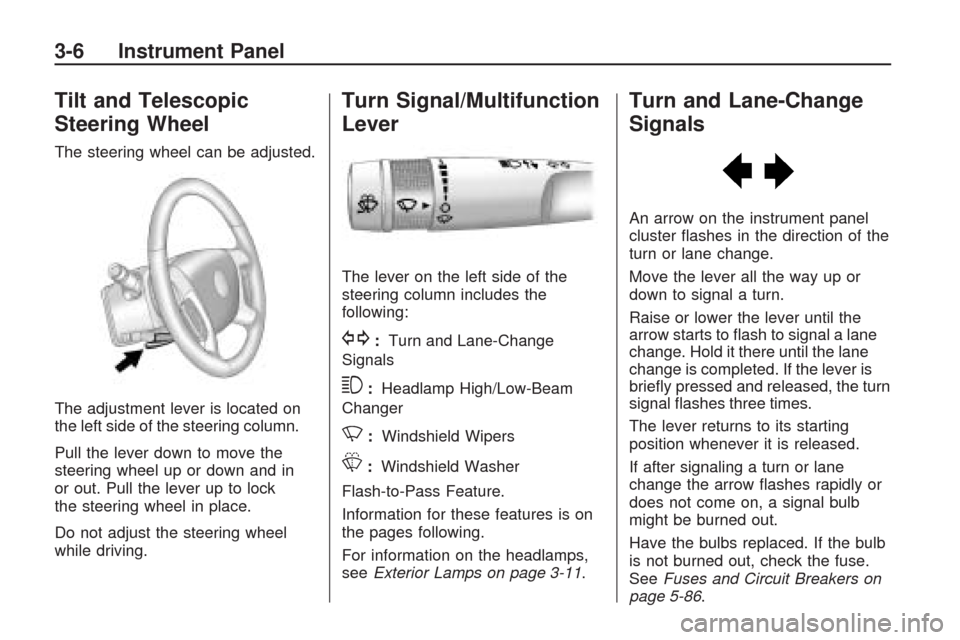
Tilt and Telescopic
Steering Wheel
The steering wheel can be adjusted.
The adjustment lever is located on
the left side of the steering column.
Pull the lever down to move the
steering wheel up or down and in
or out. Pull the lever up to lock
the steering wheel in place.
Do not adjust the steering wheel
while driving.
Turn Signal/Multifunction
Lever
The lever on the left side of the
steering column includes the
following:
G:Turn and Lane-Change
Signals
3:Headlamp High/Low-Beam
Changer
N:Windshield Wipers
L:Windshield Washer
Flash-to-Pass Feature.
Information for these features is on
the pages following.
For information on the headlamps,
seeExterior Lamps on page 3-11.
Turn and Lane-Change
Signals
An arrow on the instrument panel
cluster �ashes in the direction of the
turn or lane change.
Move the lever all the way up or
down to signal a turn.
Raise or lower the lever until the
arrow starts to �ash to signal a lane
change. Hold it there until the lane
change is completed. If the lever is
brie�y pressed and released, the turn
signal �ashes three times.
The lever returns to its starting
position whenever it is released.
If after signaling a turn or lane
change the arrow �ashes rapidly or
does not come on, a signal bulb
might be burned out.
Have the bulbs replaced. If the bulb
is not burned out, check the fuse.
SeeFuses and Circuit Breakers on
page 5-86.
3-6 Instrument Panel
Page 279 of 422
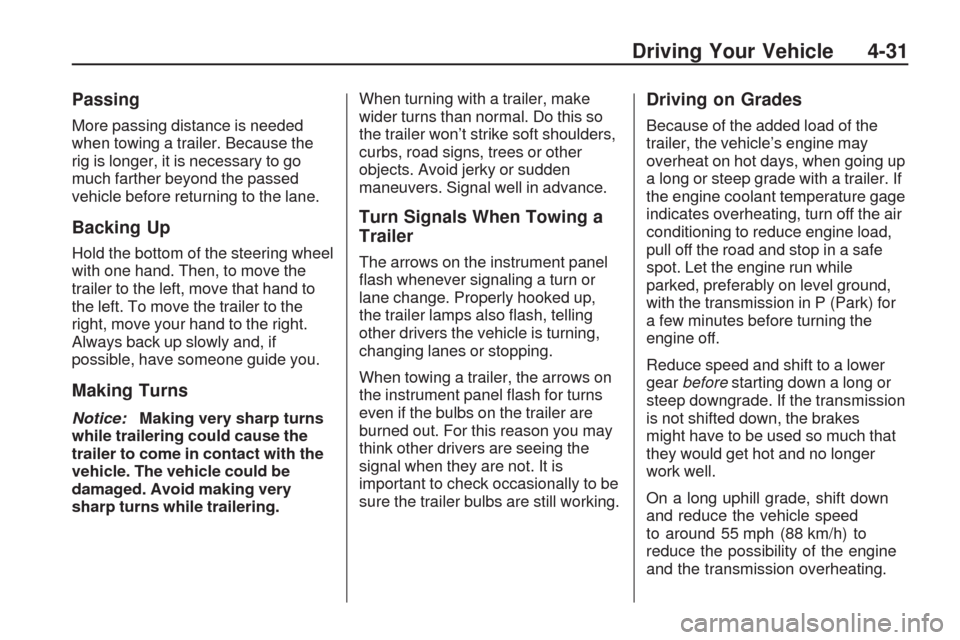
Passing
More passing distance is needed
when towing a trailer. Because the
rig is longer, it is necessary to go
much farther beyond the passed
vehicle before returning to the lane.
Backing Up
Hold the bottom of the steering wheel
with one hand. Then, to move the
trailer to the left, move that hand to
the left. To move the trailer to the
right, move your hand to the right.
Always back up slowly and, if
possible, have someone guide you.
Making Turns
Notice:Making very sharp turns
while trailering could cause the
trailer to come in contact with the
vehicle. The vehicle could be
damaged. Avoid making very
sharp turns while trailering.When turning with a trailer, make
wider turns than normal. Do this so
the trailer won’t strike soft shoulders,
curbs, road signs, trees or other
objects. Avoid jerky or sudden
maneuvers. Signal well in advance.
Turn Signals When Towing a
Trailer
The arrows on the instrument panel
�ash whenever signaling a turn or
lane change. Properly hooked up,
the trailer lamps also �ash, telling
other drivers the vehicle is turning,
changing lanes or stopping.
When towing a trailer, the arrows on
the instrument panel �ash for turns
even if the bulbs on the trailer are
burned out. For this reason you may
think other drivers are seeing the
signal when they are not. It is
important to check occasionally to be
sure the trailer bulbs are still working.
Driving on Grades
Because of the added load of the
trailer, the vehicle’s engine may
overheat on hot days, when going up
a long or steep grade with a trailer. If
the engine coolant temperature gage
indicates overheating, turn off the air
conditioning to reduce engine load,
pull off the road and stop in a safe
spot. Let the engine run while
parked, preferably on level ground,
with the transmission in P (Park) for
a few minutes before turning the
engine off.
Reduce speed and shift to a lower
gearbeforestarting down a long or
steep downgrade. If the transmission
is not shifted down, the brakes
might have to be used so much that
they would get hot and no longer
work well.
On a long uphill grade, shift down
and reduce the vehicle speed
to around 55 mph (88 km/h) to
reduce the possibility of the engine
and the transmission overheating.
Driving Your Vehicle 4-31
Page 283 of 422
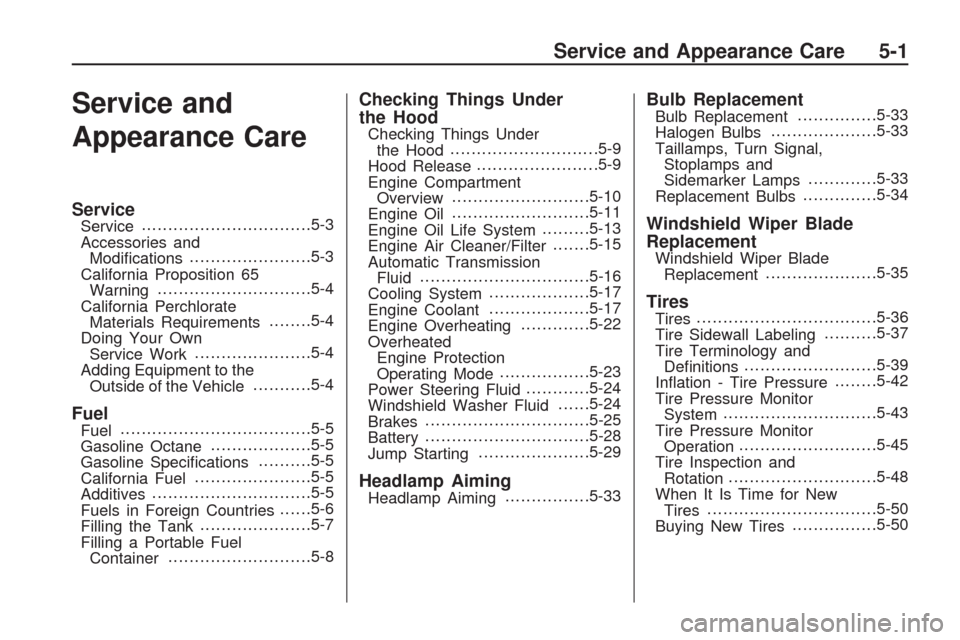
Service and
Appearance Care
ServiceService................................5-3
Accessories and
Modi�cations.......................5-3
California Proposition 65
Warning.............................5-4
California Perchlorate
Materials Requirements........5-4
Doing Your Own
Service Work......................5-4
Adding Equipment to the
Outside of the Vehicle...........5-4
FuelFuel....................................5-5
Gasoline Octane...................5-5
Gasoline Speci�cations..........5-5
California Fuel......................5-5
Additives..............................5-5
Fuels in Foreign Countries......5-6
Filling the Tank.....................5-7
Filling a Portable Fuel
Container...........................5-8
Checking Things Under
the Hood
Checking Things Under
the Hood............................5-9
Hood Release.......................5-9
Engine Compartment
Overview..........................5-10
Engine Oil..........................5-11
Engine Oil Life System.........5-13
Engine Air Cleaner/Filter.......5-15
Automatic Transmission
Fluid................................5-16
Cooling System...................5-17
Engine Coolant...................5-17
Engine Overheating.............5-22
Overheated
Engine Protection
Operating Mode.................5-23
Power Steering Fluid............5-24
Windshield Washer Fluid......5-24
Brakes...............................5-25
Battery...............................5-28
Jump Starting.....................5-29
Headlamp AimingHeadlamp Aiming................5-33
Bulb ReplacementBulb Replacement...............5-33
Halogen Bulbs....................5-33
Taillamps, Turn Signal,
Stoplamps and
Sidemarker Lamps.............5-33
Replacement Bulbs..............5-34
Windshield Wiper Blade
Replacement
Windshield Wiper Blade
Replacement.....................5-35
TiresTires..................................5-36
Tire Sidewall Labeling..........5-37
Tire Terminology and
De�nitions.........................5-39
In�ation - Tire Pressure........5-42
Tire Pressure Monitor
System.............................5-43
Tire Pressure Monitor
Operation..........................5-45
Tire Inspection and
Rotation............................5-48
When It Is Time for New
Tires................................5-50
Buying New Tires................5-50
Service and Appearance Care 5-1
Page 315 of 422
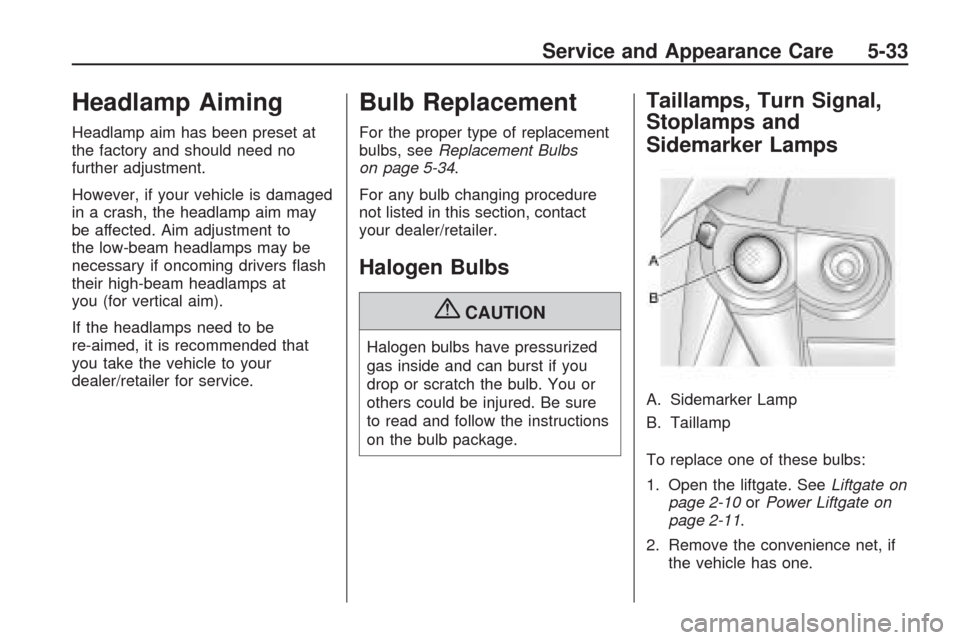
Headlamp Aiming
Headlamp aim has been preset at
the factory and should need no
further adjustment.
However, if your vehicle is damaged
in a crash, the headlamp aim may
be affected. Aim adjustment to
the low-beam headlamps may be
necessary if oncoming drivers �ash
their high-beam headlamps at
you (for vertical aim).
If the headlamps need to be
re-aimed, it is recommended that
you take the vehicle to your
dealer/retailer for service.
Bulb Replacement
For the proper type of replacement
bulbs, seeReplacement Bulbs
on page 5-34.
For any bulb changing procedure
not listed in this section, contact
your dealer/retailer.
Halogen Bulbs
{CAUTION
Halogen bulbs have pressurized
gas inside and can burst if you
drop or scratch the bulb. You or
others could be injured. Be sure
to read and follow the instructions
on the bulb package.
Taillamps, Turn Signal,
Stoplamps and
Sidemarker Lamps
A. Sidemarker Lamp
B. Taillamp
To replace one of these bulbs:
1. Open the liftgate. SeeLiftgate on
page 2-10orPower Liftgate on
page 2-11.
2. Remove the convenience net, if
the vehicle has one.
Service and Appearance Care 5-33
Page 316 of 422
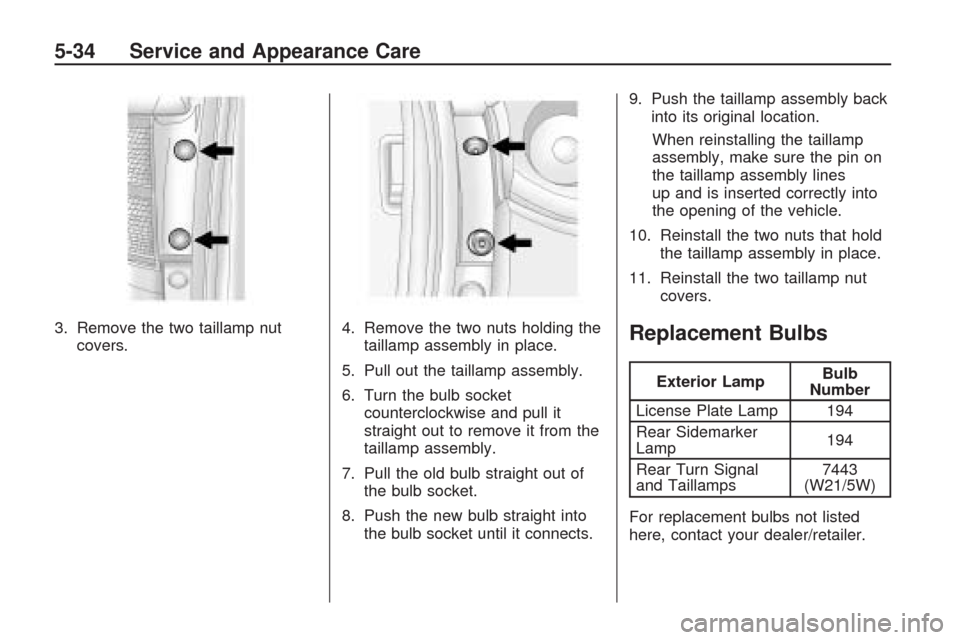
3. Remove the two taillamp nut
covers.4. Remove the two nuts holding the
taillamp assembly in place.
5. Pull out the taillamp assembly.
6. Turn the bulb socket
counterclockwise and pull it
straight out to remove it from the
taillamp assembly.
7. Pull the old bulb straight out of
the bulb socket.
8. Push the new bulb straight into
the bulb socket until it connects.9. Push the taillamp assembly back
into its original location.
When reinstalling the taillamp
assembly, make sure the pin on
the taillamp assembly lines
up and is inserted correctly into
the opening of the vehicle.
10. Reinstall the two nuts that hold
the taillamp assembly in place.
11. Reinstall the two taillamp nut
covers.Replacement Bulbs
Exterior LampBulb
Number
License Plate Lamp 194
Rear Sidemarker
Lamp194
Rear Turn Signal
and Taillamps7443
(W21/5W)
For replacement bulbs not listed
here, contact your dealer/retailer.
5-34 Service and Appearance Care
Page 412 of 422
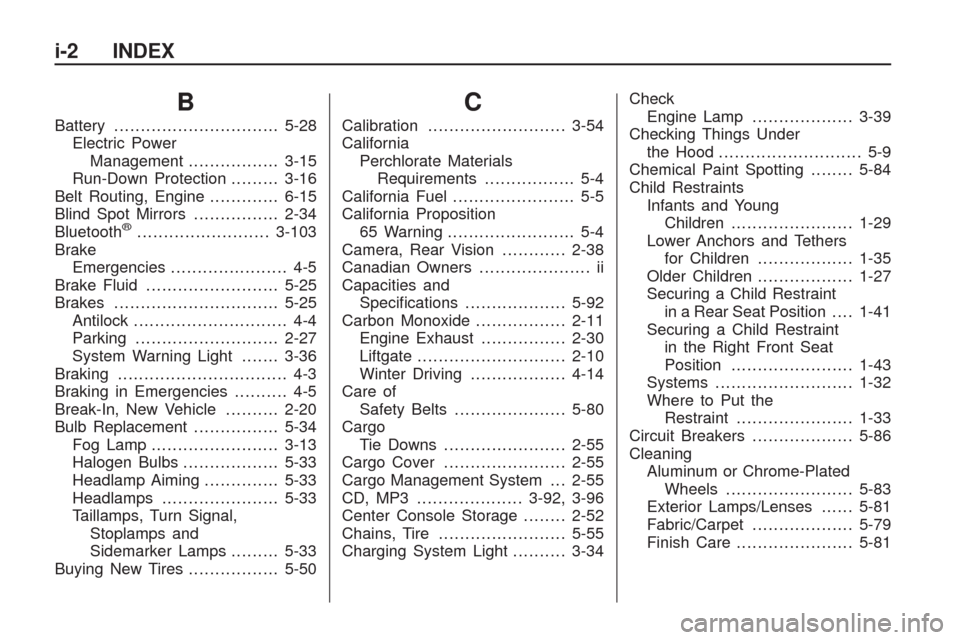
B
Battery...............................5-28
Electric Power
Management.................3-15
Run-Down Protection.........3-16
Belt Routing, Engine.............6-15
Blind Spot Mirrors................2-34
Bluetooth
®.........................3-103
Brake
Emergencies...................... 4-5
Brake Fluid.........................5-25
Brakes...............................5-25
Antilock............................. 4-4
Parking...........................2-27
System Warning Light.......3-36
Braking................................ 4-3
Braking in Emergencies.......... 4-5
Break-In, New Vehicle..........2-20
Bulb Replacement................5-34
Fog Lamp ........................3-13
Halogen Bulbs..................5-33
Headlamp Aiming..............5-33
Headlamps......................5-33
Taillamps, Turn Signal,
Stoplamps and
Sidemarker Lamps.........5-33
Buying New Tires.................5-50
C
Calibration..........................3-54
California
Perchlorate Materials
Requirements................. 5-4
California Fuel....................... 5-5
California Proposition
65 Warning........................ 5-4
Camera, Rear Vision............2-38
Canadian Owners..................... ii
Capacities and
Speci�cations...................5-92
Carbon Monoxide.................2-11
Engine Exhaust................2-30
Liftgate............................2-10
Winter Driving..................4-14
Care of
Safety Belts.....................5-80
Cargo
Tie Downs .......................2-55
Cargo Cover.......................2-55
Cargo Management System . . . 2-55
CD, MP3 ....................3-92, 3-96
Center Console Storage........2-52
Chains, Tire........................5-55
Charging System Light..........3-34Check
Engine Lamp...................3-39
Checking Things Under
the Hood ........................... 5-9
Chemical Paint Spotting........5-84
Child Restraints
Infants and Young
Children.......................1-29
Lower Anchors and Tethers
for Children..................1-35
Older Children..................1-27
Securing a Child Restraint
in a Rear Seat Position....1-41
Securing a Child Restraint
in the Right Front Seat
Position.......................1-43
Systems..........................1-32
Where to Put the
Restraint......................1-33
Circuit Breakers...................5-86
Cleaning
Aluminum or Chrome-Plated
Wheels........................5-83
Exterior Lamps/Lenses......5-81
Fabric/Carpet...................5-79
Finish Care......................5-81
i-2 INDEX